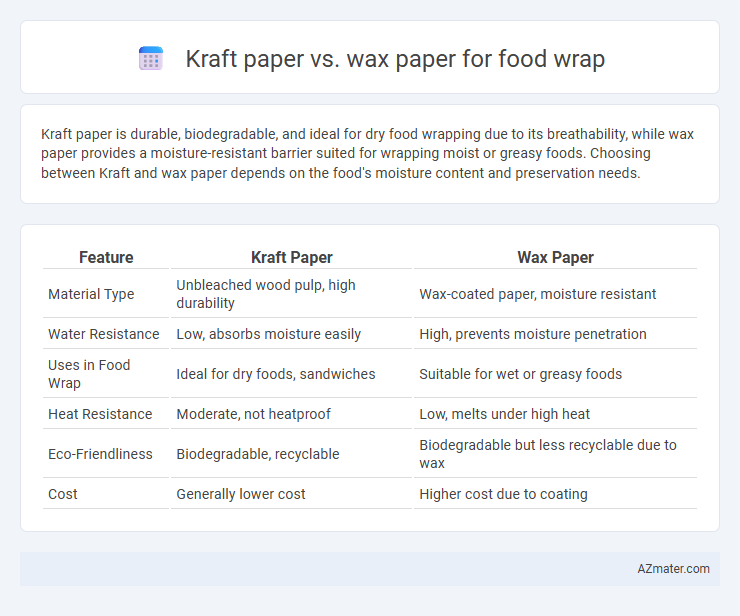Kraft paper is durable, biodegradable, and ideal for dry food wrapping due to its breathability, while wax paper provides a moisture-resistant barrier suited for wrapping moist or greasy foods. Choosing between Kraft and wax paper depends on the food's moisture content and preservation needs.
Table of Comparison
| Feature | Kraft Paper | Wax Paper |
|---|---|---|
| Material Type | Unbleached wood pulp, high durability | Wax-coated paper, moisture resistant |
| Water Resistance | Low, absorbs moisture easily | High, prevents moisture penetration |
| Uses in Food Wrap | Ideal for dry foods, sandwiches | Suitable for wet or greasy foods |
| Heat Resistance | Moderate, not heatproof | Low, melts under high heat |
| Eco-Friendliness | Biodegradable, recyclable | Biodegradable but less recyclable due to wax |
| Cost | Generally lower cost | Higher cost due to coating |
Introduction to Food Wrapping Materials
Kraft paper and wax paper differ significantly in their applications for food wrapping due to their distinct material properties. Kraft paper is a durable, biodegradable option primarily used for wrapping dry foods and providing protection during transport, while wax paper is coated with a thin layer of paraffin wax, making it moisture-resistant and ideal for wrapping items like cheese or sandwiches. Understanding these differences is essential for selecting the appropriate food wrapping material to maintain freshness and prevent contamination.
What is Kraft Paper?
Kraft paper is a durable, coarse paper made from wood pulp processed using the kraft process, renowned for its high tensile strength and resistance to tearing. It is widely used in food packaging due to its natural, biodegradable properties and ability to provide a breathable barrier that helps maintain food freshness without trapping moisture. Unlike wax paper, which is coated with a thin layer of wax to offer moisture resistance, kraft paper is uncoated, making it ideal for wrapping dry, heavier foods like sandwiches and baked goods.
What is Wax Paper?
Wax paper is a type of kitchen wrap made from paper coated with a thin layer of paraffin wax, making it moisture-resistant and non-stick. It is primarily used for wrapping food items, lining baking pans, and preventing food from sticking during preparation. Unlike Kraft paper, wax paper is not heat-resistant and should not be used in the oven or microwave.
Kraft Paper: Key Features and Benefits
Kraft paper offers superior durability and breathability compared to wax paper, making it ideal for wrapping fresh foods such as sandwiches, baked goods, and produce. Its natural, uncoated surface allows moisture to escape while protecting contents from dirt and grease, enhancing food freshness and preventing sogginess. Kraft paper is environmentally friendly, being biodegradable and recyclable, which supports sustainable packaging solutions in the food industry.
Wax Paper: Key Features and Benefits
Wax paper is coated with a thin layer of paraffin wax, making it moisture-resistant and ideal for wrapping foods that require a non-stick barrier. Its grease-resistant properties prevent oils and fats from seeping through, maintaining food freshness and presentation. Wax paper is also flexible and easy to fold, allowing for airtight wrapping that helps preserve flavor without compromising texture.
Food Safety and Hygiene Comparison
Kraft paper is biodegradable and highly breathable but lacks moisture resistance, making it less effective for wrapping greasy or wet foods and posing a higher risk of contamination. Wax paper, coated with paraffin or soybean wax, provides a moisture-proof barrier that prevents food from sticking and inhibits bacterial growth, enhancing food safety and hygiene. However, wax paper should not be used for high-heat applications due to potential melting, while kraft paper is more heat tolerant but less protective against moisture and microbes.
Environmental Impact: Kraft vs Wax Paper
Kraft paper offers a more eco-friendly alternative to wax paper due to its biodegradable and compostable properties, reducing landfill waste and environmental pollution. Wax paper often contains paraffin, a petroleum-derived substance that hinders decomposition and contributes to long-term environmental impact. Choosing kraft paper supports sustainable packaging by utilizing renewable resources and minimizing harmful chemical use in food wrapping.
Ideal Food Uses for Kraft Paper
Kraft paper is ideal for wrapping dry foods such as sandwiches, baked goods, and produce due to its breathable and sturdy nature, which helps maintain freshness without trapping moisture. Its natural, uncoated surface is food-safe and environmentally friendly, making it suitable for artisanal food packaging and takeout wraps. Unlike wax paper, Kraft paper provides better durability and grease resistance without the risk of wax melting onto food.
Ideal Food Uses for Wax Paper
Wax paper is ideal for wrapping foods that require moisture resistance and non-stick properties, such as sandwiches, baked goods, and candy. Its moisture-repellent coating prevents food from sticking and keeps items fresh without transferring flavors. However, wax paper is not heat-resistant, making it unsuitable for oven use or high-temperature cooking applications.
Which is Better for Food Wrap?
Kraft paper offers superior durability and breathability, making it ideal for wrapping dry foods like sandwiches, baked goods, and produce while preventing moisture buildup. Wax paper, coated with a thin layer of wax, provides excellent moisture resistance and prevents sticking, making it better suited for wrapping greasy or sticky foods like cheese, chocolate, and meats. Choosing between Kraft paper and wax paper depends on the food type and desired moisture control, with Kraft paper excelling in breathability and wax paper dominating in moisture and grease resistance.

Infographic: Kraft paper vs Wax paper for Food Wrap
 azmater.com
azmater.com